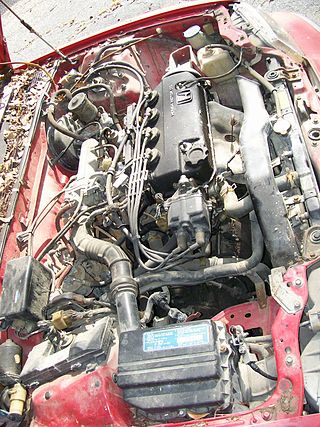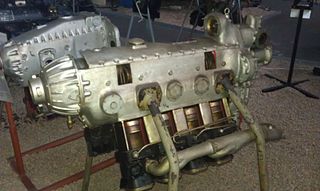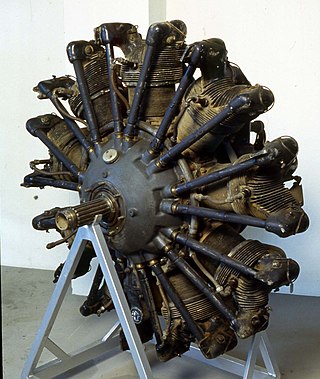| Tipo 4 | |
|---|---|
 | |
| Type | V-12 aero engine |
| Manufacturer | Lancia |
| First run | 1916 |
The Lancia Tipo 4 was an Italian aircraft engine constructed by Lancia in the mid-1910s.
| Tipo 4 | |
|---|---|
 | |
| Type | V-12 aero engine |
| Manufacturer | Lancia |
| First run | 1916 |
The Lancia Tipo 4 was an Italian aircraft engine constructed by Lancia in the mid-1910s.
This water-cooled V-12 aircraft engine was built in 1916 and had a 50-degree angle between the cylinder banks. The Tipo 4 had a 120.7 mm (4.75 in) bore and a 180.1 mm (7.09 in) stroke. The engine’s total displacement was 24.7 L (1,508 cu in). It produced 240 kW (320 hp) at 1,380 rpm and 280 kW (380 hp) at 1,420 rpm. The Tipo 4 engine was direct drive and weighed 340 kg (740 lb). The engine shipped to the United States in late 1917. [1]
Data fromOld Machine Press. [1]
Comparable engines
Related lists
The Ferrari Dino engine is a line of mechanically similar V6 and V8 engines produced by Ferrari for about 40 years from the late 1950s into the early 2000s.

The Ferrari Lampredi engine was a naturally aspirated all aluminum 60° V12 engine produced between 1950 and 1959. Inline-4 and Inline-6 variants for racing were derived from it.

The J-series is Honda's fourth production V6 engine family introduced in 1996, after the C-series, which consisted of three dissimilar versions. The J-series engine was designed in the United States by Honda engineers. It is built at Honda's Anna, Ohio, and Lincoln, Alabama, engine plants.

The Honda D series inline-four cylinder engine is used in a variety of compact models, most commonly the Honda Civic, CRX, Logo, Stream, and first-generation Integra. Engine displacement ranges between 1.2 and 1.7 liters. The D Series engine is either SOHC or DOHC, and might include VTEC variable valve lift. Power ranges from 66 PS (49 kW) in the Logo to 130 PS (96 kW) in the Civic Si. D-series production commenced 1984 and ended 2005. D-series engine technology culminated with production of the D15B 3-stage VTEC (D15Z7) which was available in markets outside of the United States. Earlier versions of this engine also used a single port fuel injection system Honda called PGM-CARB, signifying the carburetor was computer controlled.

The Piaggio P.XI was an Italian 14-cylinder radial aircraft engine. The P.XI was a licensed derivative of the French Gnome-Rhône Mistral Major 14K produced in Italy. Isotta Fraschini also produced a version of the 14K called the K.14.

The Honda R engine is an inline-four engine launched in 2006 for the Honda Civic (non-Si). It is fuel injected, has an aluminum-alloy cylinder block and cylinder head, is a SOHC 16-valve design and utilizes Honda's i-VTEC system. The R series engine has a compression ratio of 10.5:1, features a "drive by wire" throttle system which is computer controlled to reduce pumping losses and create a smooth torque curve.

The Warner Scarab is an American seven-cylinder radial aircraft engine, that was manufactured by the Warner Aircraft Corporation of Detroit, Michigan in 1928 through to the early 1940s. In military service the engine was designated R-420.

The N series is Honda's first automotive diesel engine, an inline-four for medium-sized vehicles. It uses common rail direct injection, which Honda brands as i-CTDi. The most notable feature is the aluminium block, which uses proprietary technology in the manufacturing process to provide light weight and high rigidity. Roller chains drive two overhead camshafts. A variable-geometry turbocharger and intercooler are used.
The Franklin O-175 was an American air-cooled aircraft engine of the 1940s. The engine was of horizontally-opposed four-cylinder and displaced 175 cu in (2.9 L). The power output was nominally 80 hp (60 kW). A later variant was designated O-180, despite sharing the same displacement.

The Hirth HM 508 was an air-cooled, eight-cylinder, 60° cylinder bank angle inverted-V aircraft engine built in Germany in the 1930s. It had a bore and stroke of 105 mm × 115 mm and developed 210 kW (280 hp) at 3,000 rpm.

The Fiat A.54 was a seven-cylinder, air-cooled radial engine developed in Italy in the 1930s as a powerplant for aircraft. Amongst others, it powered the Ambrosini SAI.1 and SAI.2 racing aircraft.

The Fiat A.12 was a six-cylinder liquid-cooled in-line engine with a bore of 160 mm and a stroke of 180 mm, giving a capacity of just under 22 litres, with variants producing between 245 and 300 horsepower at 1,700 rpm. The A.12 was a rather large aero engine at the time, but it was efficient and reliable. A total of 13,260 A.12s were produced between 1916 and 1919.

The Isotta Fraschini V.4 of 1916 was an Italian six-cylinder, water-cooled, in-line piston aero engine of World War I. Its construction was fairly typical of aircraft engines of the period with six cast-iron cylinders mounted in pairs with common heads. This engine was also produced by Alfa Romeo.

The Alfa Romeo D2 was a nine-cylinder radial engine for aircraft use produced in Italy. It was typically rated between 240 and 270 hp. The engine was designed by Vittorio Jano, 600 units were produced between 1931 and 1934. This engine was also the first purpose-built aircraft engine produced by Alfa Romeo, previous Alfa engines used in aircraft were derived from engines used in cars. A supercharged derivative was produced as the D2 C.30.
The Kinner C-5 was an American five cylinder radial engine for small general and sport aircraft of the 1930s.

Alessandro Anzani developed the first two-row radial from his earlier 3- cylinder Y engine by merging two onto the same crankshaft with a common crankweb.

The Asso XI was a family of water-cooled, supercharged V12 piston aeroengines produced in the 1930s by Italian manufacturer Isotta Fraschini, and fitted on a number of aircraft types built by CANT, Caproni and others.
The Franklin O-425 was an American air-cooled aircraft engine that first ran in the mid-1940s. The engine was of six-cylinder, horizontally-opposed layout and displaced 425 cu in (7 L). The power output was between 240 hp (179 kW) and 285 hp (213 kW) depending on variant. The O-405-13 (6V6-300-D16FT) of 1955 was a vertically mounted, turbocharged and fan cooled version for helicopters.

The Isotta Fraschini Asso 750 was an Italian W 18 water-cooled aircraft engine of the 1930s. Produced by Isotta Fraschini the engine displaced just under 48 L (2,900 cu in) and produced up to 940 hp (700 kW). Together with the Asso 200 and the Asso 500 the Asso 750 was part of a family of modular engines, that used common and interchangeable components to lower production costs.

The Astro 7 was a seven-cylinder radial aircraft engine built by Isotta Fraschini in the 1930s.